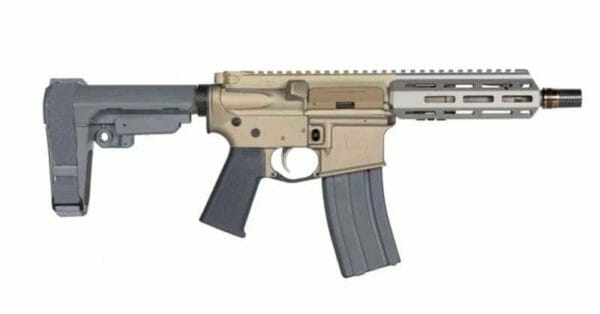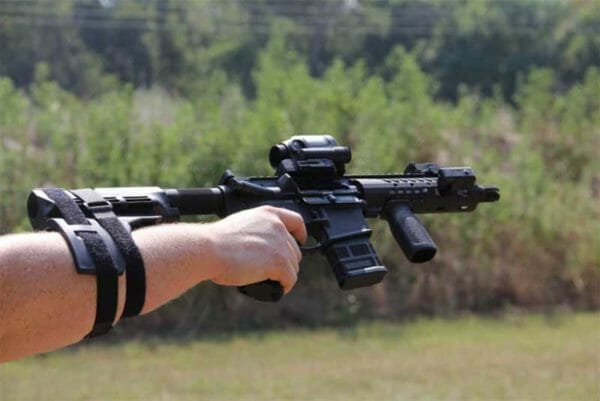Opinion by Adam Kraut, Esq.

USA – -(AmmoLand.com)- Recently, I received an email from an individual containing a letter from ATF which was a response to a correspondence requesting the correct method to “measure a firearm with a ‘stabilizing brace’ and folding adaptor.” It was explained that the correspondence was sent in the form of an email over a year ago and that the person had received a response via email shortly after it was sent. This letter was unsolicited and came over a year after the original request and response.
ATF folded brace Letter 2019
In the letter, ATF states that “[Firearms Technology Industry Services Branch] FTISB has previously determined that ‘stabilizing braces’ may be assembled on firearms as accessories…In contrast to stocks on rifles or shotguns…’stabilizing braces’ are merely accessories and not relevant to the classification of a ‘pistol’ under the statutory definition. That is, a folding stock on a rifle or shotgun is included in overall length measurements because the firearm must be ‘designed or redesigned….and intended to be fired from the shoulder‘ to be so classified. The stock is, therefore, an essential element in the statutory definition.”
Based on the letter, ATF is taking the position that because a stabilizing brace is not an integral part of the firearm, it is not relevant to the overall length measurement. Why does this matter?
A number of individuals have been building AR pistols or other similar pistols that have utilized a stabilizing brace. Some have opted to add a vertical foregrip. However, based on this interpretation, those people may find that they have manufactured an “AOW”, which is subject to the restrictions of the National Firearms Act (“NFA”).
To fully understand, it is important to look at the definitions. The term “any other weapon” is defined to include
…any weapon or device capable of being concealed on the person from which a shot can be discharged through the energy of an explosive…Such term shall not include a pistol or a revolver having a rifled bore… (emphasis added).
The term pistol is defined as
A weapon originally designed, made, and intended to fire a projectile (bullet) from one or more barrels when held in one hand… (emphasis added).
ATF has taken the position that once a vertical foregrip has been added to a firearm; it is no longer designed to be fired when held in one hand, removing it from the definition of a pistol, even though ATF previously lost this argument before the Ninth Circuit in U.S. v. Fix, 4 Fed. Appx. 324 (9th Cir. 2001).
Further, ATF has consistently held that the overall length of 26 inches is the breaking point for concealability. Put another way, if the firearm has an overall length of less than 26 inches, it places it into a category of arms that could be considered to be regulated by the NFA depending on their other characteristics. If it has an overall length greater than 26 inches, it could remove it from those class of firearms, again, depending on their characteristics.

For this particular example, if the pistol has an overall length greater than 26 inches, it is not generally considered concealable for the purposes of the AOW definition (if there was evidence that it were concealed by a person, it could still be considered an AOW). By adding a foregrip to it (per ATF’s current position), it becomes a “firearm” since it is no longer designed to be fired when held in one hand. If the overall length was less than 26 inches, and a foregrip were added, it would be classified as an AOW.
In its letter, ATF specifies that
[m]akers also create an artificial overall length measurement by attaching a folding stabilizing brace. Such a measurement would be problematic because the firearm could avoid classification as an “AOW,” yet retain the conceivability and remain fully functional. Measuring a folding (or telescoping) stabilizing brace would therefore undermine the comprehensive statutory and regulatory design of the GCA and NFA.…The measurement of a folding or collapsible stabilizing brace in the overall length of a firearm creates an artificial overall length that would permit a maker to avoid classification as an NFA “firearm” without a viable design purpose or legal justification.
It goes on to say that even stationary braces cannot be included in the overall length measurement, but the receiver extension can be.
Based on this letter, it is safe to say that ATF is taking the position that firearms equipped with stabilizing braces need to have their overall length measured with the brace folded or to the end of the receiver extension if the brace is stationary and non-adjustable. Adding a vertical foregrip to a firearm that has an overall length of less than 26 inches results in the making of an AOW, which is subject to the National Firearms Act.
If you or someone you know has questions regarding the measuring of a firearm with a stabilizing brace, contact Firearms Industry Consulting Group today to discuss YOUR rights and legal options.
Firearms Industry Consulting Group® (FICG®) is a registered trademark and division of Civil Rights Defense Firm, P.C., with rights and permissions granted to Prince Law Offices, P.C. to use in this article.
About ADAM KRAUT, ESQ.

Adam Kraut was born and raised in Chester County, PA. Active in scouting since kindergarten, Adam achieved the rank of Eagle Scout in 2004. After graduating high school, Adam attended SUNY Binghamton where he graduated in 2009 with a major in Political Science concentrating in politics and law. After taking a year away from academics, Adam attended Widener Law School at night while maintaining a day job and graduated in 2014. Adam is an avid firearms enthusiast, whose love for firearms began in Boy Scouts at Camp Horseshoe. Adam’s experience in the firearms industry as the general manager of a Federal Firearms Licensee, who is a Class 3 dealer, gives him a working knowledge of the challenges the industry, licensees and individuals face on a daily basis. Having worked with industry leaders, individual licensees and individuals both from behind the counter and in a legal context, Adam is in a unique position to give advice with insight others may not have. In addition to being active in the courtroom, Adam is politically active to ensure that the Second Amendment rights of future generations continue to be protected. He is the host of The Gun Collective‘s show, The Legal Brief, where he dispels the various legal myths and misinformation in the gun world. In his free time, Adam volunteers with his old Boy Scout troop, cranks out ammunition behind the reloading press, can be found at the range training, enjoys hiking through the woods and cares for his small pack of dogs. www.princelaw.com
